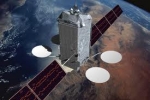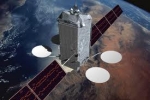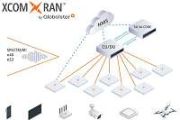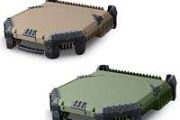Displaying items by tag: 702 family
Boeing 702 satellite
The Boeing 702 satellite is a family of geostationnary satellites designed and manufactured by the company Boeing.
Its design requirements include lower cost and high reliability. It offers a broad spectrum of modularity. A primary example is payload/bus integration. After the payload is tailored to customer specifications, the payload module mounts to the common bus module at only four locations and with only six electrical connectors. This design simplicity confers advantages. First, nonrecurring program costs are reduced, because the bus does not need to be changed for every payload, and payloads can be freely tailored without affecting the bus. Second, the design permits faster parallel bus and payload processing. This leads to the third advantage: a short production schedule.
Further efficiency derives from the 702's advanced xenon ion propulsion system (XIPS), which was pioneered by Boeing. XIPS is 10 times more efficient than conventional liquid fuel systems. Four 25-cm thrusters provide economical stationkeeping, needing only 5 kg of fuel per year - a fraction of what bipropellant or arcjet systems consume. Using XIPS for final orbit insertion conserves more mass as compared to using an on-board liquid apogee engine. Customers can apply the weight savings to increase the revenue-generating payload, to prolong service life, or to change to a less expensive launch vehicle (when cost is based on satellite mass).
Boeing 702 satellite
The Boeing 702 satellite is a family of geostationnary satellites designed and manufactured by the company Boeing.
Its design requirements include lower cost and high reliability. It offers a broad spectrum of modularity. A primary example is payload/bus integration. After the payload is tailored to customer specifications, the payload module mounts to the common bus module at only four locations and with only six electrical connectors. This design simplicity confers advantages. First, nonrecurring program costs are reduced, because the bus does not need to be changed for every payload, and payloads can be freely tailored without affecting the bus. Second, the design permits faster parallel bus and payload processing. This leads to the third advantage: a short production schedule.
Further efficiency derives from the 702's advanced xenon ion propulsion system (XIPS), which was pioneered by Boeing. XIPS is 10 times more efficient than conventional liquid fuel systems. Four 25-cm thrusters provide economical stationkeeping, needing only 5 kg of fuel per year - a fraction of what bipropellant or arcjet systems consume. Using XIPS for final orbit insertion conserves more mass as compared to using an on-board liquid apogee engine. Customers can apply the weight savings to increase the revenue-generating payload, to prolong service life, or to change to a less expensive launch vehicle (when cost is based on satellite mass).
































